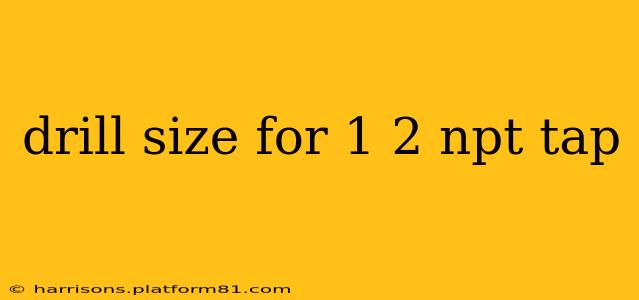Finding the right drill bit size for tapping 1/2" National Pipe Taper (NPT) threads is crucial for a clean, strong, and leak-free connection. Getting it wrong can lead to stripped threads, a loose fit, or even damage to your workpiece. This guide will delve into the specifics, addressing common questions and providing you with the information you need for success.
What Size Drill Bit Do I Need for a 1/2" NPT Tap?
The standard drill size for a 1/2" NPT tap is 5/8 inch (15.88mm). However, the ideal size can vary slightly depending on the material you're working with and your desired thread depth. Always refer to a comprehensive tap drill size chart for the most accurate information. These charts typically account for variations in materials and thread forms.
What is a Tap Drill Size Chart, and Where Can I Find One?
A tap drill size chart is a reference guide that lists the recommended drill bit sizes for various tap sizes and materials. These charts consider the thread's dimensions and the material's properties to ensure a proper fit and prevent thread damage. You can find these charts readily available online through various machining and engineering resources, or in hardware stores.
What Happens If I Use the Wrong Drill Bit Size?
Using an incorrectly sized drill bit can lead to several problems:
-
Too Small: The tap may struggle to cut the threads, leading to stripped threads in the workpiece or a broken tap. The threads may also be too shallow, compromising the strength and leak-proof seal of the connection.
-
Too Large: This results in loose threads that won't adequately hold the fitting. The pipe may not grip firmly, leading to leaks or a weak joint, especially under pressure.
What Materials Affect Drill Size Selection for NPT Taps?
The material you're tapping significantly affects the ideal drill bit size. Harder materials require a larger drill bit to ensure the tap cuts cleanly and doesn't break. Softer materials might require a slightly smaller drill bit to prevent excessive thread deformation. Consult a tap drill size chart that specifies the recommended drill size for different materials like steel, brass, aluminum, or plastic.
How Important is Pilot Hole Accuracy When Tapping NPT Threads?
Accuracy is paramount. A properly sized pilot hole ensures the tap threads accurately and cleanly without binding or breaking. A pilot hole that's too small can lead to a broken tap, while a pilot hole that's too large will produce loose threads. Always use a drill press for optimal accuracy and control, particularly for precision work.
What Other Tools and Techniques Are Needed for Successful NPT Tapping?
Beyond the correct drill bit, several other factors contribute to successful NPT tapping:
-
Cutting Fluid: Use cutting fluid or lubricant during the tapping process to facilitate smoother cutting, reduce friction, and prevent chip buildup. This is especially important for harder materials.
-
Proper Tap Technique: Use even pressure and avoid forcing the tap. Rotate it slowly and steadily, ensuring it cuts the threads correctly without binding. Use a tap wrench for better control, especially on larger taps.
-
Cleanliness: Keep the work area clean to avoid damaging the tap or workpiece. Clean away debris frequently during the tapping process.
By paying careful attention to detail and using the correct tools and techniques, you can achieve a successful 1/2" NPT tap every time. Remember always to consult a tap drill size chart for the most accurate and reliable information specific to your application.
